I’d always wanted a flowery mead. (AKA – a bulb lawn for the less romantic among us). And to be honest it took the help of flowerbulbs.com to finally get me there.
I started as many garden makers do – too timid and too light-handed with my intentions. Back in 2011, I wrote about how I was experimenting with the mead and the plants I was choosing. Note how I was all inspired by the bulbs that existed before I arrived but then I was trying to populate it with everything but bulbs?
Sometimes I miss the most obvious cues/ clues.
There are many ways to re-wild your lawn. Bending it towards a more diverse meadow is an exciting endeavor that will make your garden not only prettier but a better ecological resource. But if you want the easiest way to get started, adding a collection of underplanted spring bulbs is the quickest path to spring enlightenment.
My wildly successful bulb lawn story started last year and in the spirit of building on successes – I’m expanding on it this fall.
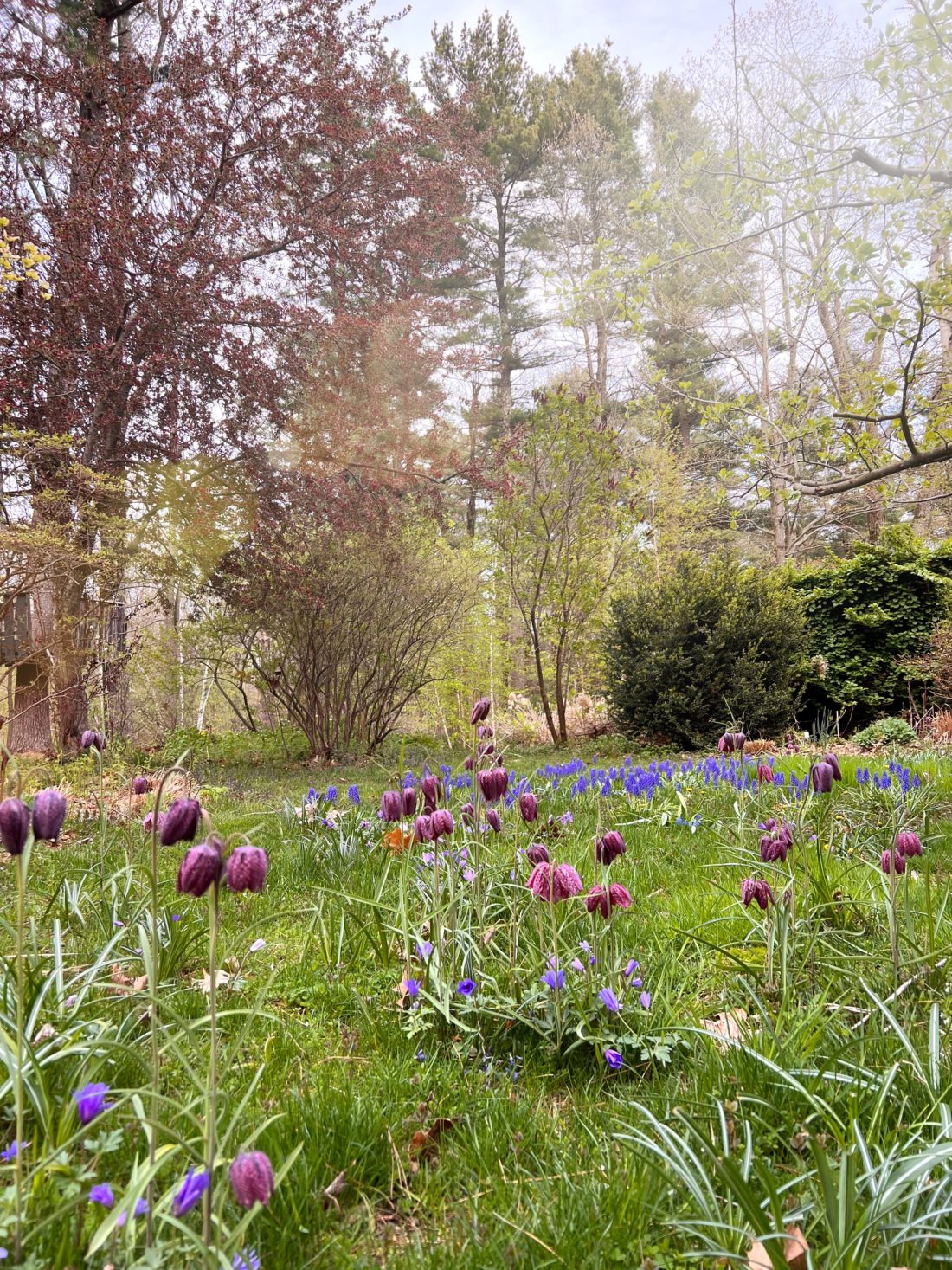
The bulb lawn and it derivations go by many names. Flowery mead (medieval), Old English mæd, or just a meadow (an evolution of the mæd). The style known is also sometimes known as “millefleur”, meaning “thousand flowers”. It was also referred to as ‘Ings’ by old Norse and the Dutch call it a stinzenplanten or stinze garden. But the basics are the same – ephemerals and bulbs are planted under a grassy matrix (a lawn).
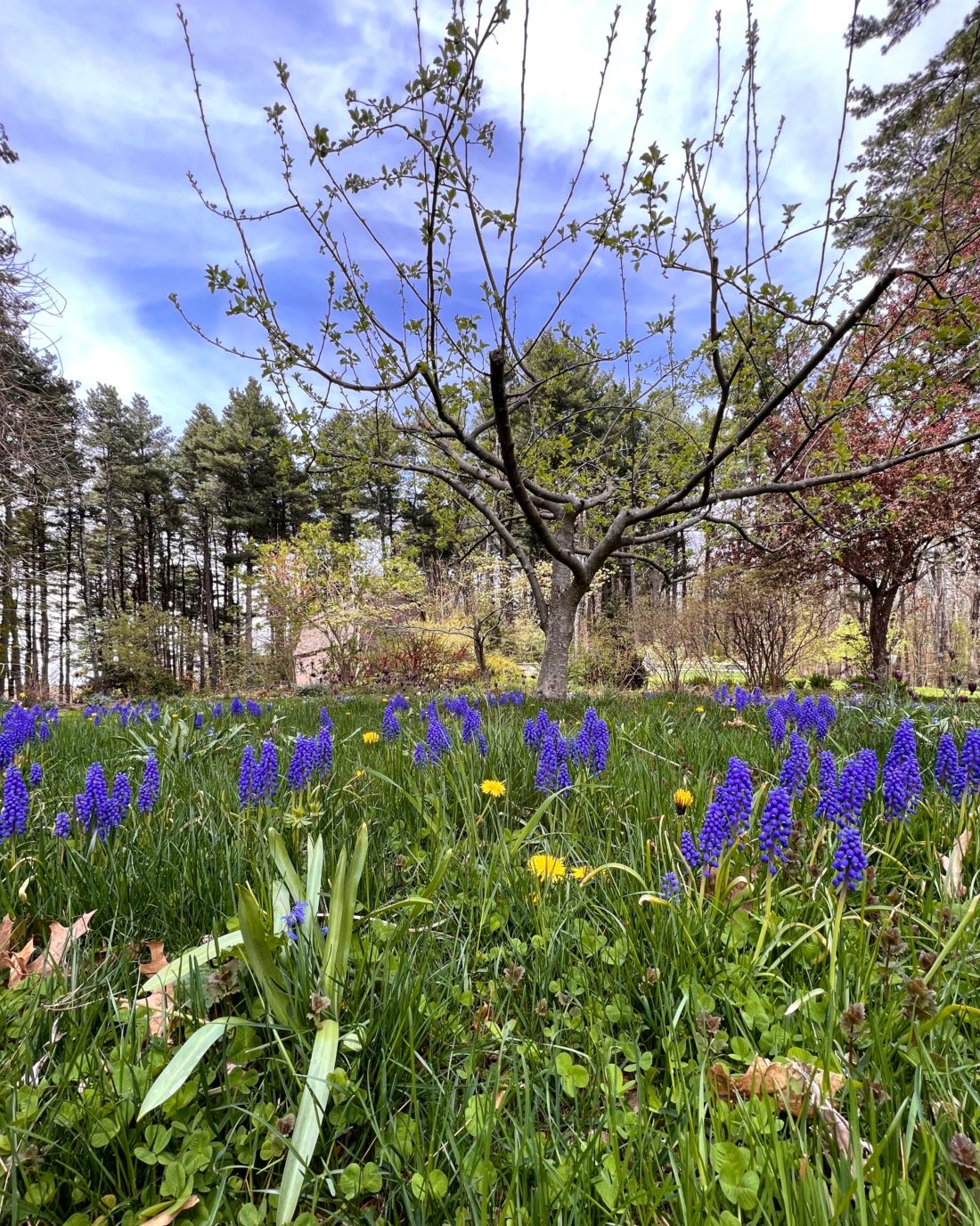
Reasons to Plant a Bulb Lawn:
There is no doubt that any garden installation that doesn’t require future work is one that you will eventually love more than something you have to tend and tinker with constantly. Even if you choose pottering in the garden over all other hobbies – I guarantee, there will come a day when you will value above all else, the things that are amazing even in your laziest, or most overwhelmed and neglectful seasons of life.
Installing a bulb lawn is the first step down a path of true low maintenance garden making.
The best thing about a stinzen lawn is that you plant it once and it is done. Forever.
These bulbs (you must choose them wisely – but I’ve included a list below to get your started) will multiply. And, despite your nothing-more effort – you’ll get more flowers every year.
There are plants that are an investment because they are rare, or slow or hard to grow or uniquely exotic and then there are the ones that are like buying Amazon stock in 1997.
Time and patience (and nothing else on your part) transforms a small act into a vast profusion of riches.
These bulbs are called naturalizers – meaning that they will slowly spread over time. The will not disperse seeds all over the place, (which often need to be weeded out later). Nor will they send runners to all the places you don’t want them. Rather, they will kindly plump out and create a carpet of chubby clumps where singles once stood.
Turf bulbs provide important early season pollen and nectar for pollinators.
A bulb lawn will burst into bloom before the grass is green. Snow drops and winter aconite will sometimes bloom beneath a layer of snow or will bravely poke through it to remind us that spring will actually come. (Even if sometimes it seems soo far away).
Choose single flowering bulbs so insect can reach the pollen and nectar more easily. (Most all of the bulbs below check this requirement. So you can feel confident that early bees will find their first syrup laced flowers in your garden).
Bulb lawns are Squirrel, Rodent and Deer Resistant
You can also take comfort that you aren’t spending your hard earned dollars buying chipmunk caviar.
With the exception of tulips and crocus, the bulbs in this list are generally not eaten by
Squirrels or other rodents and deer generally will not eat the flowers.
My garden is eaten by everything (moles, voles, woodchucks, deer, raccoons, bears, mice, chipmunks and more…) – but the bulbs that I planted in the stinzenplanten last year were entirely untouched.
(I’m knocking on wood that it stays that way!)
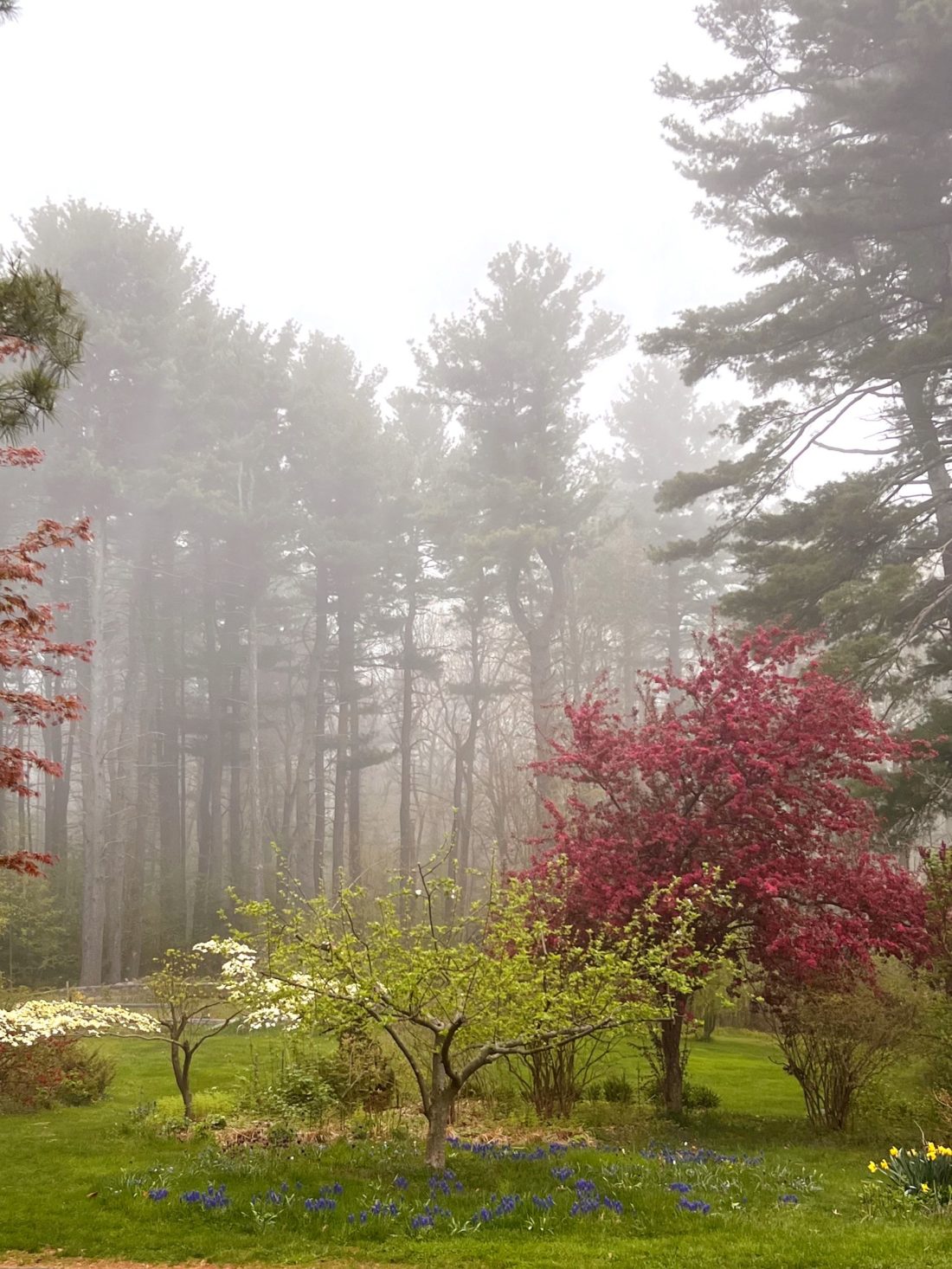
Bulb Lawns are Weed Free, Naturally
A garden that is planted in a matrix of grass never needs to be weeded. The grass and whatever else makes up your lawn (in my case in addition to the turf, there is a lovely mix of moss, clover, dandelions, creeping charlie and ajuga) keeps any other weeds at bay. The look is wilder, so you can comfortably let go of weeding work and stress in the name of fully embracing the style.
I keep my bulb lawn tidier by planting it in a precise circle centered on an apple tree. As the the bulbs grow, so does the grass. I mow around the edges – keeping a tidy line, and I love the way the contrast between the long grass and the short grass create their own design feature.
I didn’t mow the grass until well into July because I loved the look so much. It made No Mow May an easy challenge and the tall grass was good for wildlife.
(Weirdly, my dog seemed to love to use this less tidy area more than the rest of the lawn making his clean up a little easier too).
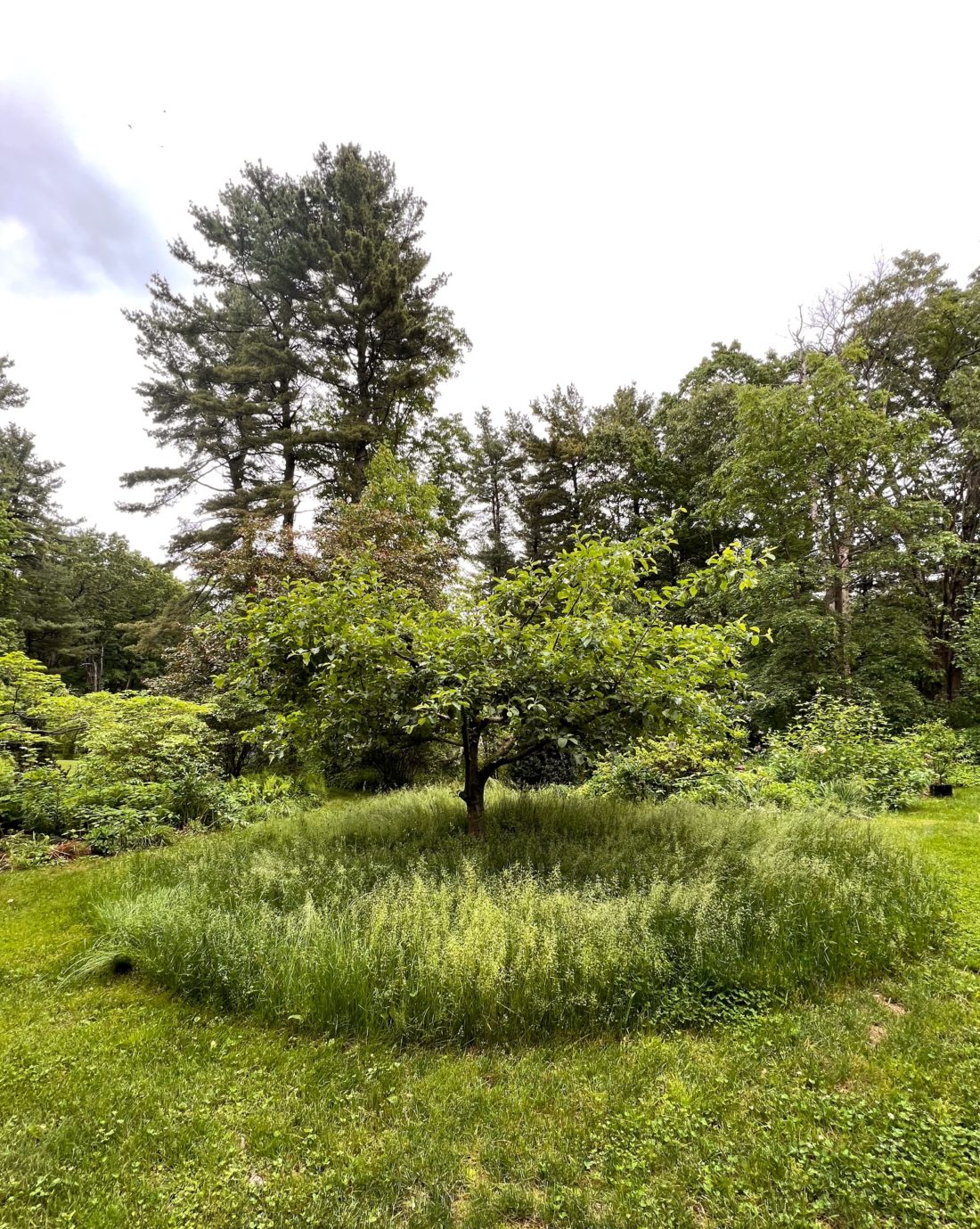
If you live in a drought prone area, bulb lawns are a low water solution.
You will need to water the bulbs in when you plant them- especially if the soil is dry. But once they are planted, they are very low input. I never water mine (I live in not so dry New England). In a very arid climate, you might want to keep an eye on them for very small watering inputs. (Once or twice after planting is usually enough). Generally speaking – rain and snow will be enough water.
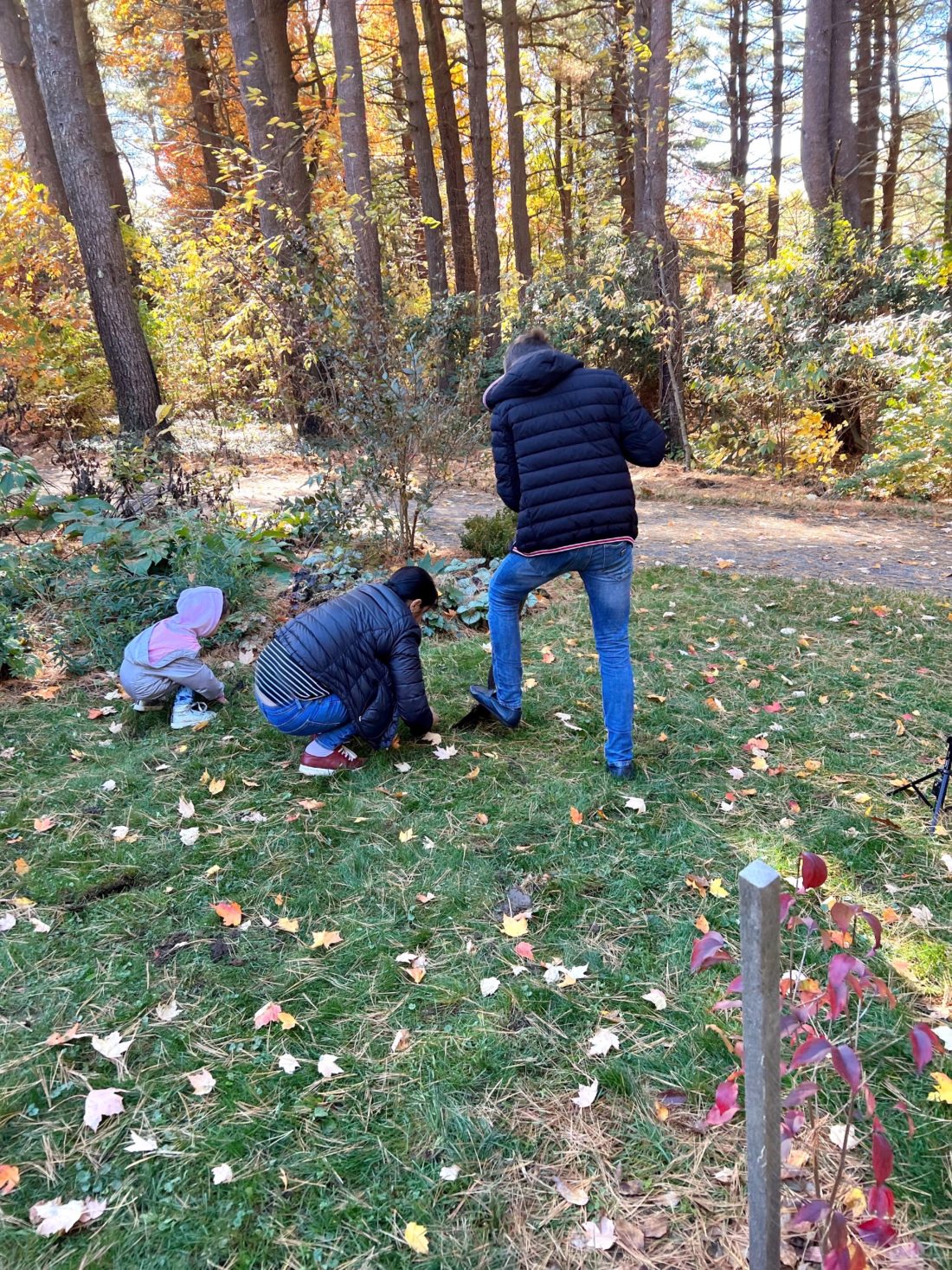
How to Plant Bulbs Under Your Lawn – The Easy Way
There is an art to choosing the best place to grow a bulb lawn.
Choose a low traffic area – perhaps opt for the front lawn garden over the back garden if you have children or if your lawn is used as a play area.
I chose an area around the base of an apple tree last year and this year, I repeated the idea of planting around a tree.
I added a baby dogwood tree to an open area of lawn and then planted a similar sized circle around the base of the tree.
(In my case, I gave the tree a 2′ radius around the base that did not have bulbs and then I extended the bulb ring to a circle that was 12′ from the base).
The area under trees are naturally low traffic and also they can often be areas where grass can be difficult to grow. The bulbs will generally thrive under a tree (most trees do not have leaves to shade them in the early spring) so achieving a full sun aspect is easier than you might think.
Other great areas to grow a bulb lawn might be in a hellstrip, as a fade from a wilder area to a more controlled area, over a septic system (these are not deep growing plants) or beneath an orchard.
Key areas to avoid planting a bulb lawn is if you have a poorly draining spot or if the soil pH is strongly acidic or basic. (A bulb lawn will thrive in an area where the pH is close to neutral).
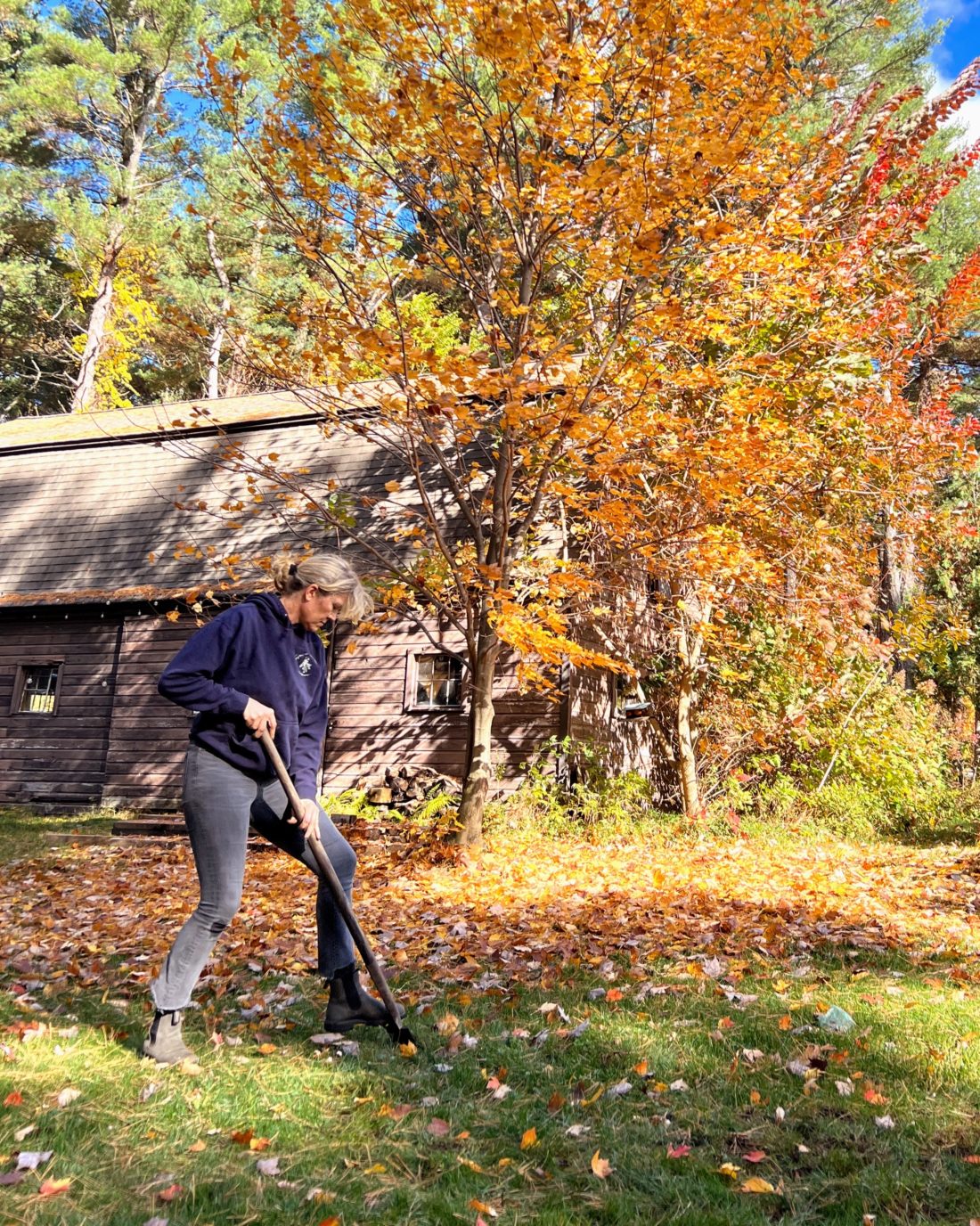
When to Plant a bulb lawn
September to October — Zones 4 and 5
October to early November — Zones 6 and 7
November to early December — Zones 8 and 9
Late December to early January — Zone 10
>>Google your zip code and the term ‘planting zone’ to confirm what zone you are in.
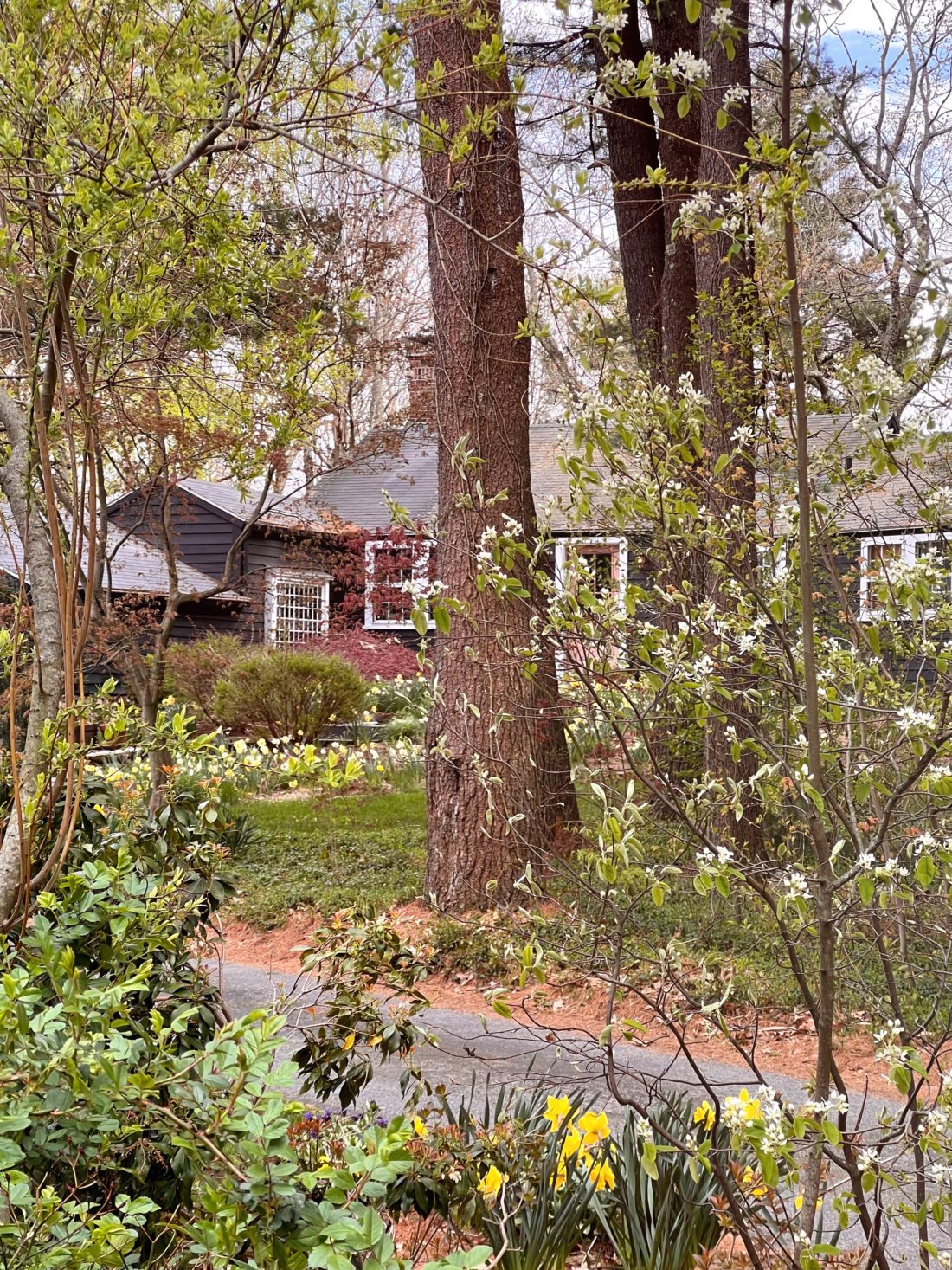
My Favorite Squirrel and Rodent Resistant Bulbs for Naturalizing and Bulb Lawns:
- Early Snowdrops – Galanthus nivalis and other varieties
- Winter Aconite –Eranthis hyemalis
- Early Snow Glories – Chionodoxa
- Star of Holland – Also know as Siberian Squill – Scilla siberica. (please check the invasive status of this bulb where you live – it can be aggressive, it can take over a lawn and it can jump into the wild in many places and it can be difficult to get rid of.)
- Giant Dutch Crocus – Crocus vernus and other varieties – you can choose a range of colors.
- Blue Shades anemone – Grecian windflower – Anemone blanda ‘Blue Shades’
- Blue Grape Hyacinths – Muscari armeniacum
- Guinea-Hen Flower – Fritillaria meleagris
You can also add species tulips and mini daffodils, but I have chosen to leave those out of my planting since I have lots of other large daffodils through my garden and I didn’t want to add another color (red) to my planting with the tulips. The selection above will mostly be shades of yellow, blue, purple and white.
Lastly – Having the right tools always makes the job easier. I have a nice flat spade (like this one) that easily cuts the grass squarely and also I used a hori hori knife to help cut the turf as I rolled it back – but I suspect that an actual turf cutter tool might have made it even easier.
Share this post:
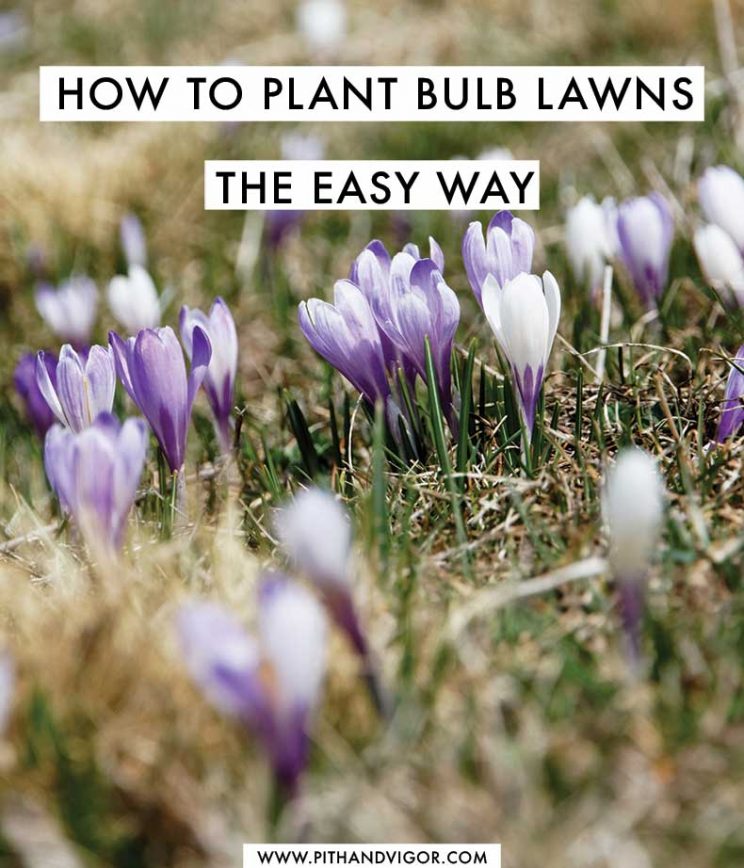
Other Post your might like:
This post is sponsored by Flowerbulbs.com.
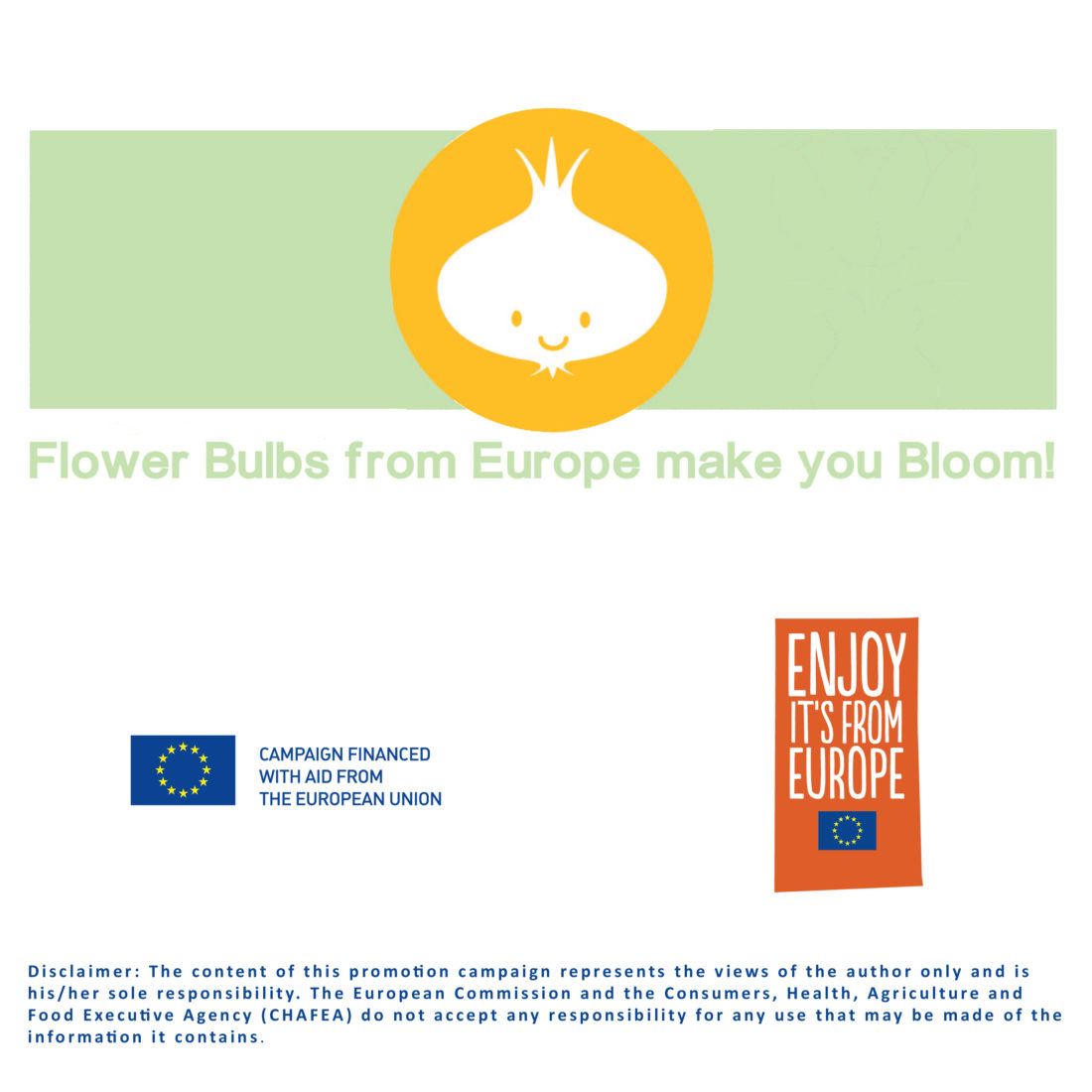
The town I live in (Takoma Park, MD.) has many homes that in the spring have Crocus tomasianus covering the entire lawn. Breathtakingly beautiful. This is thanks to the homeowner/gardeners planting them in the 1st half of the 20th century and now 75 years later we reap the rewards. Thanks for the post, Rochelle.
I much prefer to have my bulbs in a bed. I don’t like the messy look of bulbs in a lawn, too weedy for a city garden. If I had a large meadow it might look OK.
Love it (and love that dark brown soil!). If my beds are full of variety, why should my lawn-ish not be too? As long as it’s low, and can handle foot traffic, I’m happy for it to not be pristine turf. I fell for flowers in the turf while visiting English gardens. Their single, white Bellis in turf is charming. The closest I can come is white clover though we’ve also planted crocus and daffs. I’m also charmed by the Colchicum hillside at Chanticleer each fall.
I have to say — I am towards the weedy lawn look — but I wasn’t always – growing up in the midwest and remembering people (like my parents) talking enviously about the shades of green that other people (on the other side of the fence) had achieved with their grassy perfection – it had an impact. But then I lived in England and was completely charmed by the variance, and lived in and loved look of something less perfect and more natural. Now I have moss in my grass (and some bulbs leftover a previous owner) and I relish and encourage it all. The only thing I need to rid myself of is the thistle….it simply must be barefoot ready.
Caroline — I would love to see those crocus….maybe you can feature them sometime!
Eddie – agree an urban are might be too much — but many of the spring ephemerals are there and gone before the grass even greens up – and then you can mow them down with the first cut. I think a possible nice season extension.
Eddie – I too long for that soil…I have it in some places — but not under my lawn…plus it is filled (or was filled) with the nasty white grubs that killed it.
That’s an interesting barometer to use…I like it! I definitely like things to look like they took off on their own. They’re not weeds, they’re flowers, is my way of thinking. But then, I’m not a lawn person, either….
I like the look of daffodils tumbling down a hill, or tucked at the end of a row of shrubbery. I’m willing to deal with dying foliage. Hyacinth foliage lasts a long time, I tuck them in the edges of perennial beds where they’ll be hidden while they ripen.
There is a great chapter on bulbs in the lawn in Lauren Springer Ogden’s new edition of The Undaunted Garden. It’s not that messy looking because the foliage of the crocus is fine like grass. I say, Do It!!
These look beautiful.